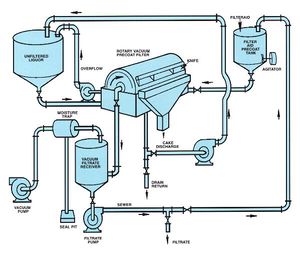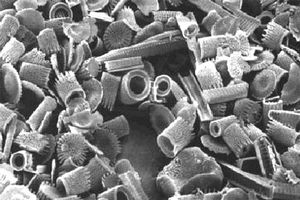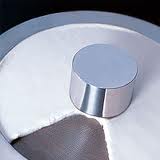Filter Aids
Filter Aids is a group of inert materials that can be used in filtration pretreatment. Certain filter aids may be used to aid filtration. These are often incompressible diatomaceous earth, or kieselguhr, which is composed primarily of silica. Also used are wood cellulose and other inert porous solids such as the cheaper and safer perlite.
These filter aids can be used in two different ways. They can be used as a precoat before the slurry is filtered. This will prevent gelatinous-type solids from plugging the filter medium and also give a clearer filtrate. They can also be added to the slurry before filtration. This increases the porosity of the cake and reduces resistance of the cake during filtration. In a rotary filter, the filter aid may be applied as a precoat; subsequently, thin slices of this layer are sliced off with the cake.
The use of filter aids is usually limited to cases where the cake is discarded or where the precipitate can be chemically separated from the filter.
Objectives
There are two objectives related to the addition of filter aids. One is to form a layer of second medium which protects the basic medium of the system. This is commonly referred to as “precoat”. The second objective of filter aids is to improve the flow rate by decreasing cake compressibility and increasing cake permeability.
General types
The common filter aids are diatomaceous earth (DE), perlite, cellulose and others. Diatomaceous earth (DE) is the skeleton of ancient diatoms. They are mined from ancient seabed, processed, and classified to make different grade of filter aids. DE is the most commonly used filter aid today. However, the crystalline type DE is a suspicious carcinogen and inhalation needs to be avoided during handling.
There are different grades of commercial DE. A finer grade may be employed to increase the clarity of filtrate. The smaller the filter aid particle size, the smaller the process particles can be removed. However, the filtration rate is lower. There is always a balance between initial filtrate clarity and filtration rate. The particle size capture by various filter aids may also vary because of liquid viscosity, surface charge, etc.
Perlite is another important mineral filter aid. It is a particular variety of naturally occurring glassy volcanic rock, characterized by onion like, splintery breakage planes. After crushing and heating, this rock will expand in an explosive fashion to about ten times its original volume.
Diatomaceous earth and perlite are silica based minerals. There are several other special materials used as filter aids, including asbestos, cellulose, agricultural fibers, saw dust, rice hull ash, paper fibers etc.
Cellulose can be used for filtration system that cannot tolerate silica. The filterability of cellulose is much worse than DE or perlite but cellulose can be incinerated as well as providing better cake integrity. Calcined rice hull ash and fibers from used newspapers are relatively new filter aids. They are used for wastewater sludge dewatering.
Video


